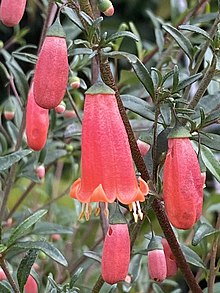Correa pulchella
Correa pulchella, commonly known as the salmon correa,[2] is a species of small prostrate to erect shrub that is endemic to South Australia. It has glabrous, leathery, narrow oblong to broadly egg-shaped leaves and pendulous, cylindrical, pink to red or orange flowers arranged singly on short side branches.
| Salmon correa | |
|---|---|
 | |
| Scientific classification | |
| Kingdom: | Plantae |
| Clade: | Tracheophytes |
| Clade: | Angiosperms |
| Clade: | Eudicots |
| Clade: | Rosids |
| Order: | Sapindales |
| Family: | Rutaceae |
| Genus: | Correa |
| Species: | C. pulchella |
| Binomial name | |
| Correa pulchella | |
| Synonyms[1] | |
| |
Description
Correa pulchella is a prostrate to erect shrub that typically grows to a height of 1 m (3 ft 3 in) and has smooth branchlets. The leaves are more or less glabrous, arranged in opposite pairs, narrow oblong to broadly egg-shaped or trowel-shaped, 10–20 mm (0.39–0.79 in) long and 3–15 mm (0.12–0.59 in) wide on a petiole 3–5 mm (0.12–0.20 in) long. The flowers are arranged singly on short side branches on a thin, pendulous pedicel 5–12 mm (0.20–0.47 in) long. The calyx is green, broadly hemispherical, 3–5 mm (0.12–0.20 in) long and the corolla is cylindrical or funnel-shaped, pink to red or orange, rarely white, 10–30 mm (0.39–1.18 in) long with the stamens about the same length as the corolla. Flowering mainly occurs from April to September.[2][3][4][5]
Taxonomy
Correa pulchella was first formally described in 1827 by Robert Sweet in his book Flora Australasica from an unpublished description by John Bain Mackay. The seeds had been collected on Kangaroo Island by William Baxter who had been sent to Australia by the plant collector Francis Henchman and grown by Mackay in his Clapton Nursery.[6][7][8]
Use in horticulture
Correa pulchella is regarded as one of the most attractive Correa species.[9] It prefers dry summers with low humidity and well-drained alkaline soils.[9] Propagation from seed is difficult, however semi-mature stem cuttings strike readily.[9] It has gained the Royal Horticultural Society's Award of Garden Merit.[10]
Cultivars
Cultivars include:
- 'Little Cate', a seedling selection of garden origin with prominently displayed bright pink flowers. It is thought to be a hybrid between two different forms.[11]
- 'Pink Mist', a pale-pink flowering form selected from a wild population on the southern Yorke Peninsula .[12]
- 'Dusky Bells', Correa pulchella × Correa reflexa
References
- "Correa pulchella". Australian Plant Census. Retrieved 14 July 2020.
- "Correa pulchella". Seed Conservation Service of South Australia. Retrieved 14 July 2020.
- Wilson, Paul G.; Wilson, Annette J.G. (ed.). "Correa pulchella". Australian Biological Resources Study, Department of Agriculture, Water and the Environment: Canberra. Retrieved 14 July 2020.CS1 maint: extra text: authors list (link)
- "Correa pulchella". State Herbarium of South Australia. Retrieved 14 July 2020.
- Wilson, Paul Graham (1961). "A taxonomic revision of the Genus Correa". Transactions of the Royal Society of South Australia. 85: 40–42. Retrieved 14 July 2020.
- "Correa pulchella". APNI. Retrieved 14 July 2020.
- Sweet, Robert (1827). Flora Australasica. London: James Ridgway. p. 1. Retrieved 14 July 2020.
- Barker, Robyn M. (2007). "The botanical legacy of 1802: South Australian plants collected by Robert Brown and Peter Good on Matthew Flinders' Investigator and by the French scientists on Baudin's Géographe and Naturaliste" (PDF). Journal of the Adelaide Botanic Gardens. 21: 16. Retrieved 14 July 2020.
- "Correa pulchella". Australian Native Plants Society (Australia). Archived from the original on 9 June 2009. Retrieved 7 May 2009.
- "RHS Plant Selector - Correa pulchella". Retrieved 15 April 2020.
- "Correa 'Little Cate'". Australian Cultivar Registration Authority. Retrieved 6 May 2009.
- "Correa 'Pink Mist'". Australian Cultivar Registration Authority. Retrieved 6 May 2009.